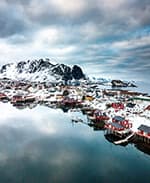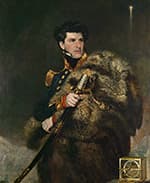- The Arctic and Antarctic – natural realms at the poles
- > At first glance, the Earth’s two polar regions appear to have much in common: Their terrestrial and marine landscapes are characterized by ice and snow, darkness dominates for half of the year, and survival is limited to those organisms that can adapt to very extreme conditions. But in spite of the striking parallels there are fundamental differences between the Arctic and Antarctic – ranging from their geography and history of ice formation to their conquest by humankind.

The Arctic and Antarctic – two fundamentally different polar regions
The north and south polar regions are among the most remote and extreme environments for life on Earth. In both regions freezing temperatures, ice, snow and the darkness of the long polar nights make it difficult for plants, animals and humans to survive. Yet the two regions are also fundamentally different from one another. In the south, Antarctica is a vast continent surrounded completely by the Southern Ocean. In the north, the exact opposite applies to the Arctic. Here, the land masses of three continents effectively surround an ocean located in the centre. The only ice sheet in the Arctic covers a large portion of Greenland. But this is still significantly smaller than the Antarctic Ice Sheet, which covers 98 per cent of the continent. On the other hand, the Arctic Ocean possesses a permanent sea-ice cover. Its surface area grows and shrinks in response to the rhythm of the seasons, never diminishing as much as the sea-ice surface in the Southern Ocean, which melts almost completely in summer. In the geological history of Earth, extensive ice cover over both polar regions at the same time is an exceptional situation. There have only been a few times in the past when the drifting continents have been arranged such that climatic conditions in both the northern and southern hemispheres favoured the icing of the poles. While the climate history of Antarctica is now quite well understood, many open questions remain about the history of ice formation in the Arctic land and marine regions. The geographical differences between the two polar regions account for their different human settlement histories. Most land areas of the Arctic have been accessible to humans on foot. Coming out of North Africa, they settled in Siberia about 45,000 years ago, and later trekked from there over a land bridge into North America. However, people were only able to settle in Greenland and the northernmost reaches of Europe after the ice sheets of the most recent glacial period had melted. Until then, massive ice had blocked the northward routes in North America and Europe for the hunters and gatherers. Today around four million people live in the Arctic. In order to reach the more remote Antarctic, it took seaworthy ships and brave seafarers who dared to sail far to the south. The southern continent thus was not discovered until the 19th century and was initially seen only as a seal and whale hunting ground. From the 20th century onward, adventurers and polar researchers explored the icy continent directly, yet in the public eye advances into unknown regions were often more interesting than scientifically relevant data and observations. After the First World War, modern technology was increasingly applied in polar research. Both the Arctic and Antarctic regions began to be explored from the air. With the establishment of research stations, it became possible to carry out long-term surveys, which improved the ability to predict weather in the polar regions. Furthermore, the significance of the two regions for the Earth’s climate was recognized. International scientific cooperation then laid the foundations for the Antarctic Treaty System, which entered into force in 1961 and to this day ensures the protection and peaceful, purely scientific use of the continent. There is no comparable contractual framework for the Arctic region. Despite divergent political interests, researchers from a variety of nations are working hand in hand in both polar regions. The extreme climate and isolated conditions in the two regions present humankind with special logistical and technical challenges that can often only be overcome by working together.

